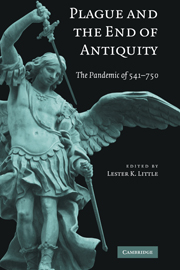Book contents
- Frontmatter
- Contents
- Contributors
- Preface
- Map
- Plague and the End of Antiquity
- I INTRODUCTION
- II THE NEAR EAST
- III THE BYZANTINE EMPIRE
- IV THE LATIN WEST
- V THE CHALLENGE OF EPIDEMIOLOGY AND MOLECULAR BIOLOGY
- 11 Ecology, Evolution, and Epidemiology of Plague
- 12 Toward a Molecular History of the Justinianic Pandemic
- Bibliography
- Index
11 - Ecology, Evolution, and Epidemiology of Plague
Published online by Cambridge University Press: 05 June 2012
- Frontmatter
- Contents
- Contributors
- Preface
- Map
- Plague and the End of Antiquity
- I INTRODUCTION
- II THE NEAR EAST
- III THE BYZANTINE EMPIRE
- IV THE LATIN WEST
- V THE CHALLENGE OF EPIDEMIOLOGY AND MOLECULAR BIOLOGY
- 11 Ecology, Evolution, and Epidemiology of Plague
- 12 Toward a Molecular History of the Justinianic Pandemic
- Bibliography
- Index
Summary
Many of the essays in this volume focus on the Justinianic Plague in relation to particular geographical areas. This essay sets out to complement the various regional perspectives by offering a general overview of the ecology, evolution, and epidemiology of plague. It is argued here, in opposition to recent heretical views, that the most important plague epidemics recorded by historical sources, such as the Justinianic Plague and the Black Death, were indeed caused by the species of non-motile, gram-negative bacteria called Yersinia pestis, commonly known as plague. However, the author does have some sympathy with the theory, advocated by Shrewsbury in his magnum opus on plague in the British Isles and later applied to Renaissance Italy by Carmichael, that some of the lesser “plague” epidemics recorded in historical sources might have been caused by other pathogens, particularly typhus and meningitis.
There are three possible ways of trying to identify the pathogen that was responsible for the Justinianic Plague. First, a retrospective diagnosis can be made by studying the descriptions of the symptoms of the disease in early medieval authors. Second, the techniques of the molecular biology laboratory can be applied to the past to investigate ancient biomolecules (DNA, RNA, proteins, and lipids) extracted from human skeletal remains. Third, the behavior of the pathogen in question can be characterized by examining its epidemiology.
- Type
- Chapter
- Information
- Plague and the End of AntiquityThe Pandemic of 541–750, pp. 231 - 289Publisher: Cambridge University PressPrint publication year: 2006
- 5
- Cited by

